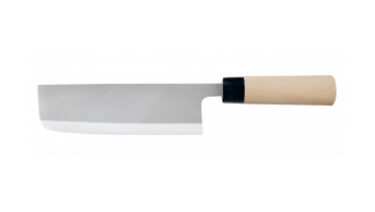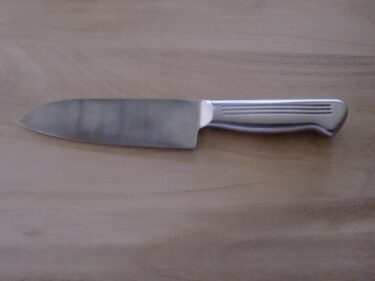Deba knives are used to cut fish. If you like fishing or cooking fish, you must have at least one of these knives.
However, there are many types of Deba knives. They are different in terms of materials, blade sizes, and brands, and many people may not know which one is suitable for them.
In this article, we will introduce basic information on Deba knives, how to choose one, and our recommended Deba knives.
Uses and Features of Deba Knives
Deba knives are specially designed for cutting fish. They feature a short blade which is thick and wide enough to cut through bone.
They’re great knives for people who buy and cook whole fish as well as fishing enthusiasts.
Most materials are made of stainless steel or steel. Also available for left-handed users.
There are also small Deba knives with a blade length of 10 to 11 cm, which is ideal for handling small fish such as horse mackerel.
Also, some people use Deba knives to cut meat as well as fish around the home. A gyuto or santoku knife is more suitable for cutting meat, but unless you are a professional chef who cuts meat, you can manage just fine with a Deba knife.
A Yanagiba knife is recommended for slicing sashimi after fish has been cut. The blade is long and thin, so it can cut in a single motion and is very sharp.
How to Choose the Best Deba knife
“How should I choose a deba kitchen knife?”
Here are some tips on how to choose a Deba kitchen knife.
Select the Length of the Blade
The most important point in choosing a Deba knife is the length of the blade. If you often cut small fish such as horse mackerel or sardines, a small Deba knife with a blade length of about 10cm is recommended. This is a popular choice for home use.
If you want to cut larger fish such as hamachi, you should choose a Deba knife with a blade of 15cm or longer. This is an authentic Deba knife used by professional chefs.
There are also knives with a blade length of 20cm or more, but they require a certain level of skill to handle, so they aren’t recommended for use around the home.
Select the Blade Material
The material of the blade is also an important factor to consider when choosing a Deba knife. If you want to focus on sharpness, choose a steel Deba knife. Steel is much sharper than other materials, which makes it is easy to cut. However, it tends to rust easily and needs to be cleaned frequently.
If you are looking for a knife that is easy to clean, stainless steel knives are the best choice. It is slightly less sharp than steel, but it is rust-resistant and easy to sharpen, so it is suitable for people who do not want to spend too much time on maintenance and beginners.
Select a Handle
When choosing a knife, it’s important to select not only the blade but also the handle. The first thing to consider is the material of the handle. The material of the handle can be roughly divided into wood, buffalo horn, ebony, and stainless steel.
The best material for use around the home and beginners is wood. It’s light, resistant to water, and does not slip when held with wet hands.
The more you use it, the more comfortable it will become in your hands.
If you are more particular about its appearance or want to use it for a long time, we recommend a handle made of buffalo horn or ebony. Many of the knives used by professional chefs are made of buffalo horn or ebony.
Stainless steel handles are easy to clean. The handle is made of stainless steel and is easy to clean, especially when the blade and handle are seamless. Compared to wooden handles, stainless steel handles have a heavier feel and provide more stability for cutting.
The shape of the handle also affects the ease of use. Most Deba knives have an oval handle that’s easy to grip.
While most knives used by professional chefs have an octagonal handle. The price tends to be a little higher, but it’s suitable for detailed work.
Some stainless steel knives have a special shape that makes them easier to grip.
Everyone has their own preference, so try out different shapes to find the one that suits you best.
Select According to Your Dominant Hand
Deba knives are basically single-edged for right-handed people, which is a feature of Japanese knives.
This is not to say that left-handed people can’t use it, but it will be a bit difficult to use. If you are left-handed, you should choose a left-handed knife, although it will be slightly more expensive.
There are also ambidextrous knives available. The sharpness is inferior to that of a single-edged knife, but it is recommended when there are both right-handed and left-handed users.
What is the Best Way to Care for a Deba Knife?
Once you get the hang of it, sharpening a Deba kitchen knife is easier than you think. In addition to sharpening with a whetstone, you can also use a knife sharpener to make it easier. Some varieties cannot be sharpened, so be careful.
If you are a beginner, you can usually use a knife sharpener and sharpen it with a whetstone once every three months. Regular sharpening will keep your knives sharp and make cooking more enjoyable. We recommend you don’t dismiss sharpening as a hassle, but give it a try.
Do not leave steel knives wet after use. Thoroughly wipe them dry frequently to prevent rusting. It is especially important to wash and dry them thoroughly after using them to cut acidic foods such as lemons, as they rust easily.
Summary
A Deba knife is a convenient knife for cutting fish. It is important to choose the right knife for you according to the size of the fish, sharpness of the blade, ease of cleaning, ease of gripping the handle, and your handedness.
If you can find a good Deba knife, you’ll certainly enjoy cooking fish more deliciously. If you have never had a Deba knife before, give it a try?



